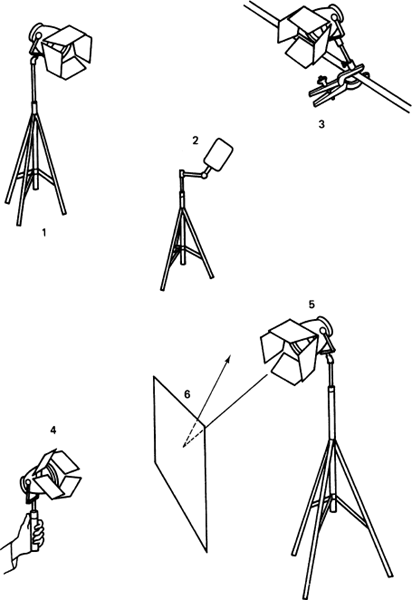On Location: Lighting and Accessories
Portability and light weight are the key features of location equipment for use on simple shoots.
A recce of a location will indicate the level of lighting required. A kit of three or four small spotlights and one or two lightweight 2 kW spotlights, all with lightweight stands, would meet most needs. Large interiors may require additional lights to be hired, together with a generator if local power is inadequate or unavailable.
A battery-powered lamp can usefully fill dark corners or provide localised contrast control. HMI, MSR and CID lamps are discharge lamps with an approximately daylight colour temperature. They are high intensity sources but are expensive, discharge sources are usually hired unless frequently used.
Folding white reflectors or sheets of polystrene can be effective in reducing contrast by reflecting sunlight into shadows or softening the effect of hard lights. Large soft lights can be a useful alternative to diffused hard light, especially if there is a large area to light. Metal flaps (french flags) supported by brackets or stands in front of a lamp to take light off specific parts of the scene are sometimes useful. Important accessories include spring-loaded calipers (gaffer grips) for fixing lamps to convenient abutments, pipes etc., rolls of neutral filter (scrim) to soften the effect of the spotlights, and rolls of blue and half-blue filter to match the colour of the lights to daylight when working in mixed daylight and artificial light. Bulldog clips to attach the filter, mains extension leads, spare bulbs and fuses complete the lighting kit.
Monitor
A portable battery-powered monitor can be a major asset when lining up shots and for checking recordings, but it can be a time waster and battery guzzler unless used with care.
Clapper board and stopwatch
‘Marking’ a shot with a clapper board showing the shot and take numbers during the run-up time of the videotape machine is a useful aid to editing, though clapping the board is unnecessary as there are no synchronisation problems between sound and vision. A stopwatch for shot timing can also be useful.
Time-code generator
Most portable cameras generate time-code automatically, generally set to zero at the beginning of a shoot, although sometimes directors prefer to use the time of day.
Waterproof covers
All equipment liable to be exposed to the weather should have waterproof covers that do not impede operational controls.

Typical location lighting equipment
(1) Small portable light on a stand. (2) French flag on stand to restrict area on which light falls. (3) Small spotlight clamped to an overhead pipe with a gaffer grip. (4) Small hand-held battery light. (5) Larger 2 kW spotlight with reflector (6) to soften effect of light.
